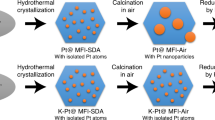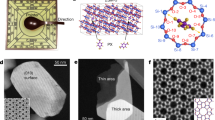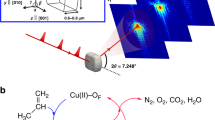Abstract
Single-molecule imaging with atomic resolution is a notable method to study various molecular behaviours and interactions1,2,3,4,5. Although low-dose electron microscopy has been proved effective in observing small molecules6,7,8,9,10,11,12,13, it has not yet helped us achieve an atomic understanding of the basic physics and chemistry of single molecules in porous materials, such as zeolites14,15,16. The configurations of small molecules interacting with acid sites determine the wide applications of zeolites in catalysis, adsorption, gas separation and energy storage17,18,19,20,21. Here we report the atomic imaging of single pyridine and thiophene confined in the channel of zeolite ZSM-5 (ref. 22). On the basis of integrated differential phase contrast scanning transmission electron microscopy (iDPC-STEM)23,24,25, we directly observe the adsorption and desorption behaviours of pyridines in ZSM-5 under the in situ atmosphere. The adsorption configuration of single pyridine is atomically resolved and the S atoms in thiophenes are located after comparing imaging results with calculations. The strong interactions between molecules and acid sites can be visually studied in real-space images. This work provides a general strategy to directly observe these molecular structures and interactions in both the static image and the in situ experiment, expanding the applications of electron microscopy to the further study of various single-molecule behaviours with high resolution.
This is a preview of subscription content, access via your institution
Access options
Access Nature and 54 other Nature Portfolio journals
Get Nature+, our best-value online-access subscription
$29.99 / 30 days
cancel any time
Subscribe to this journal
Receive 51 print issues and online access
$199.00 per year
only $3.90 per issue
Buy this article
- Purchase on Springer Link
- Instant access to full article PDF
Prices may be subject to local taxes which are calculated during checkout




Similar content being viewed by others
Data availability
The data supporting the findings of this study are available from the corresponding authors on request.
References
Temirov, R., Soubatch, S., Luican, A. & Tautz, F. S. Free-electron-like dispersion in an organic monolayer film on a metal substrate. Nature 444, 350–353 (2006).
Gross, L., Mohn, F., Moll, N., Liljeroth, P. & Meyer, G. The chemical structure of a molecule resolved by atomic force microscopy. Science 325, 1110–1114 (2009).
Gross, L. et al. Organic structure determination using atomic-resolution scanning probe microscopy. Nat. Chem. 2, 821–825 (2010).
Weiss, C., Wagner, C., Temirov, R. & Tautz, F. S. Direct imaging of intermolecular bonds in scanning tunneling microscopy. J. Am. Chem. Soc. 132, 11864–11865 (2010).
Zhang, J. et al. Real-space identification of intermolecular bonding with atomic force microscopy. Science 342, 611–614 (2013).
Koshino, M. et al. Imaging of single organic molecules in motion. Science 316, 853 (2007).
Liu, Z., Yanagi, K., Suenaga, K., Kataura, H. & Iijima, S. Imaging the dynamic behaviour of individual retinal chromophores confined inside carbon nanotubes. Nat. Nanotechnol. 2, 422–425 (2007).
Zhang, D. et al. Atomic-resolution transmission electron microscopy of electron beam-sensitive crystalline materials. Science 359, 675–679 (2018).
Li, Y. et al. Cryo-EM structures of atomic surfaces and host-guest chemistry in metal-organic frameworks. Matter 1, 428–438 (2019).
Shen, B., Chen, X., Shen, K., Xiong, H. & Wei, F. Imaging the node-linker coordination in the bulk and local structures of metal-organic frameworks. Nat. Commun. 11, 2692 (2020).
Shen, B. et al. Atomic spatial and temporal imaging of local structures and light elements inside zeolite frameworks. Adv. Mater. 32, 1906103 (2020).
Yuan, W. et al. Visualizing H2O molecules reacting at TiO2 active sites with transmission electron microscopy. Science 367, 428–430 (2020).
Shen, B. et al. A single-molecule van der Waals compass. Nature 592, 541–544 (2021).
Corma, A. From microporous to mesoporous molecular sieve materials and their use in catalysis. Chem. Rev. 97, 2373–2419 (1997).
Davis, M. E. Ordered porous materials for emerging applications. Nature 417, 813–821 (2002).
Li, Y. & Yu, J. New stories of zeolite structures: their descriptions, determinations, predictions, and evaluations. Chem. Rev. 114, 7268–7316 (2014).
Corma, A. Inorganic solid acids and their use in acid-catalyzed hydrocarbon reactions. Chem. Rev. 95, 559–614 (1995).
Busca, G. Acid catalysts in industrial hydrocarbon chemistry. Chem. Rev. 107, 5366–5410 (2007).
Yilmaz, B. & Müller, U. Catalytic applications of zeolites in chemical industry. Top. Catal. 52, 888–895 (2009).
Rinaldi, R. & Schuth, F. Design of solid catalysts for the conversion of biomass. Energy Environ. Sci. 2, 610–626 (2009).
Olsbye, U. et al. The formation and degradation of active species during methanol conversion over protonated zeotype catalysts. Chem. Soc. Rev. 44, 7155–7176 (2015).
Kokotailo, G. T., Lawton, S. L., Olson, D. H., Olson, D. H. & Meier, W. M. Structure of synthetic zeolite ZSM-5. Nature 272, 437–438 (1978).
Lazic, I., Bosch, E. G. T. & Lazar, S. Phase contrast STEM for thin samples: integrated differential phase contrast. Ultramicroscopy 160, 265–280 (2016).
Lazić, I. & Bosch, E. G. T. Analytical review of direct STEM imaging techniques for thin samples. Adv. Imaging Electron Phys. 199, 75–184 (2017).
Yucelen, E., Lazic, I. & Bosch, E. G. T. Phase contrast scanning transmission electron microscopy imaging of light and heavy atoms at the limit of contrast and resolution. Sci. Rep. 8, 2676 (2018).
Borade, R. B., Adnot, A. & Kaliaguine, S. Acid sites in dehydroxylated Y zeolites: an X-ray photoelectron and infrared spectroscopic study using pyridine as a probe molecule. J. Chem. Soc. Faraday Trans. 86, 3949–3956 (1990).
Zhang, W., Cu, S., Han, X. & Bao, X. In situ solid-state NMR for heterogeneous catalysis: a joint experimental and theoretical approach. Chem. Soc. Rev. 41, 192–210 (2012).
Paul, G. et al. Combined solid-state NMR, FT-IR and computational studies on layered and porous materials. Chem. Soc. Rev. 47, 5684–5739 (2019).
Boronat, B. & Corma, A. What is measured when measuring acidity in zeolites with probe molecules? ACS Catal. 9, 1539–1548 (2019).
Liu, L. et al. Direct imaging of atomically dispersed molybdenum that enables location of aluminum in the framework of zeolite ZSM-5. Angew. Chem. Int. Ed. 59, 819–825 (2019).
Kirkland, E. J. Advanced Computing in Electron Microscopy (Springer, 2010).
Lazić, I. & Bosch, E. G. T. Analytical review of direct STEM imaging techniques for thin samples. Adv. Imaging Electron Phys. 199, 75–184 (2017).
Bosch, E. G. T. & Lazić, I. Analysis of HR-STEM theory for thin specimen. Ultramicroscopy 156, 59–72 (2015).
Bosch, E. G. T. & Lazić, I. Analysis of depth-sectioning STEM for thick samples and 3D imaging. Ultramicroscopy 207, 112831 (2019).
Perdew, J. P., Burke, K. & Ernzerhof, M. Generalized gradient approximation made simple. Phys. Rev. Lett. 77, 3865–3868 (1996).
Kresse, G. & Furthmüller, J. Efficient iterative schemes for ab initio total-energy calculations using a plane-wave basis set. Phys. Rev. B 54, 11169–11186 (1996).
Blöchl, P. E. Projector augmented-wave method. Phys. Rev. B 50, 17953–17979 (1994).
Grimme, S. Accurate description of van der Waals complexes by density functional theory including empirical corrections. J. Comput. Chem. 25, 1463–1473 (2004).
Grimme, S. Semiempirical GGA-type density functional constructed with a long-range dispersion correction. J. Comput. Chem. 27, 1787–1799 (2006).
LeBeau, J. M., Findlay, S. D., Allen, L. J. & Stemmer, S. Position averaged convergent beam electron diffraction: theory and applications. Ultramicroscopy 110, 118–125 (2010).
Allen, L. J., D’Alfonso, A. J. & Findlay, S. D. Modelling the inelastic scattering of fast electrons. Ultramicroscopy 151, 11–22 (2015).
Acknowledgements
This work was supported by the National Key Research and Development Program of China (no. 2020YFB0606401), the National Natural Science Foundation of China (nos. 22005170, 21771029 and 202013981) and the National Key R&D Program of China (2017YFB0602204). We are grateful to the Tsinghua National Laboratory for Information Science and Technology for assistance with the energy simulation. B.S. is also thankful for the support from Suzhou Key Laboratory of Functional Nano & Soft Materials, Collaborative Innovation Center of Suzhou Nano Science & Technology, the 111 Project.
Author information
Authors and Affiliations
Contributions
B.S., X.C. and F.W. conceived this project and designed the studies; B.S. and X.C. performed the electron microscopy experiments and data analysis; H.W. prepared the zeolite samples and carried out the first-principles calculations; H.X., E.G.T.B. and I.L. performed the simulation of iDPC-STEM images; all authors were involved in the data analysis; B.S. wrote the manuscript, with the help of the other authors.
Corresponding authors
Ethics declarations
Competing interests
The authors declare no competing interests.
Peer review
Peer review information
Nature thanks Hamish Brown and the other, anonymous, reviewers for their contribution to the peer review of this work.
Additional information
Extended data
is available for this paper at https://doi.org/10.1038/s41586-022-04876-x.
Publisher’s note Springer Nature remains neutral with regard to jurisdictional claims in published maps and institutional affiliations.
Extended data figures and tables
Extended Data Fig. 1 Thin (quasi-2D) areas in ZSM-5 crystal.
a, Annular dark-field STEM image showing the lateral view of the thin area in ZSM-5 crystal. The thickness of the thin area is about 4 nm, which can be measured from this lateral view. b,c, Thickness mapping and profile analysis by EELS. The measured thickness of this thin area is also about 4 nm. d, PACBED pattern at the thin area of ZSM-5 crystal. The simulated pattern for a sample thickness of 6 nm is given to compare with the experimental result. e, Profile analysis of the experimental and simulated PACBED patterns to estimate the thickness of this thin area. The position of profiles is given in d. The inset shows the least-squares fitting of the experimental PACBED pattern with the simulated ones, indicating that this area is about 6 nm thick.
Extended Data Fig. 2 Analysis of empty channel and vertical pyridine.
a, Structural model, simulated and experimental images of an empty ZSM-5 channel. b, Structural model, simulated and experimental images of the ZSM-5 channel with a vertical pyridine (without acid sites).
Extended Data Fig. 3 Calculated near-horizontal pyridine configurations.
a, Numbered T and O sites in the ZSM-5 (MFI) framework. b–k, Calculated structural models of pyridine molecules with the lowest interaction energy when bonding with different acid sites. Here we only show these ten acid site positions, because for other positions pyridines will be adsorbed into sinusoidal channels that cannot be imaged from this [010] projection. The stable pyridine configuration in c, when setting the acid site at O2, is consistent with the imaged results in Fig. 3.
Extended Data Fig. 4 More images in Stage 3 of the in situ experiment.
The iDPC-STEM images are continuously captured at different times during the desorption of pyridines (Stage 3).
Extended Data Fig. 5 Statistics of pyridine features in each channel after heat treatment.
There are about 45% empty channels, about 33% channels with near-horizontal pyridines and about 22% channels with vertical pyridines.
Extended Data Fig. 6 TGA and IR spectroscopy of the pyridines in ZSM-5.
a, TGA result of the pyridine/ZSM-5 sample. The sample stays at 120 °C (boiling point of pyridine) for 1 h to completely remove bulk or surface pyridines. The inset shows the peaks of pyridine desorption. At around 200 °C, most of the pyridines adsorbed mainly by van der Waals interactions were desorbed, whereas the remaining pyridines strongly bonding with the acid sites were also desorbed at over 300 °C. b, IR spectroscopy of protonated pyridines bonding with the acid sites at 200 and 350 °C. The peak at about 1,540 cm−1 indicates the N–H bonds in the protonated pyridines, which strongly interact with the Brønsted acid sites. This result shows that, in this temperature range, there are still some protonated pyridines (with near-horizontal configurations) confined in ZSM-5 channels.
Extended Data Fig. 7 iDPC-STEM images of the pyridine/ZSM-5 samples through heating.
a, iDPC-STEM image before heating (saturated van der Waals adsorption). b, iDPC-STEM image after heating at 200 °C outside the scanning transmission electron microscope. c, Different kinds of pyridine configuration in ZSM-5 channels after heating. More magnified iDPC-STEM images of the near-horizontal pyridine configurations are given, the sizes of which agree with the model of pyridine molecules.
Extended Data Fig. 8 Effects of thermal vibration and noise on iDPC-STEM images.
a, Effect of thermal vibration on iDPC-STEM images studied by image simulations. The sigma of TDS ranges from 0.1 to 0.5. b, Effect of Poisson noise on iDPC-STEM images studied by image simulations. The electron doses in the simulations are 1,500 and 3,000 e− Å−2, respectively. The thickness is 4 nm (2-unit-cell thickness). c, Simulated image with no TDS and noise with a profile direction (white arrow) for the profile analysis in d and e. d,e, Profile analysis to show the effects of thermal vibration and noise on iDPC-STEM images.
Extended Data Fig. 9 More profile analysis of the single molecules in ZSM-5 channel.
a–d, Comparison between the raw (a), Gaussian-filtered (b and d) and simulated (c) images of the pyridine discussed in Fig. 3. e,f, Profile analysis of these images to demonstrate the consistency of the experimental and simulated results. Two profile directions are marked by the red and blue arrows in d. g,h, Structural models and simulated images of two thiophenes discussed in Fig. 4. i,j, Profile analysis of the experimental and simulated images. Two profile directions are marked by the red and blue arrows in g and h.
Extended Data Fig. 10 Calculated near-horizontal thiophene configurations.
a, Numbered T and O sites in ZSM-5 (MFI) framework. b–k, Calculated structural models of thiophene molecules with the lowest interaction energy when bonding with different acid sites. Here we only show these ten acid site positions, because for other positions thiophene will be adsorbed into sinusoidal channels that cannot be imaged from this [010] projection. The S atoms in thiophenes are just pointing to acid sites to identify the positions of these acid sites. The thiophene configurations in e and i, when setting the acid site at O8 and O19, are consistent with the imaged results in Fig. 4.
Rights and permissions
About this article
Cite this article
Shen, B., Wang, H., Xiong, H. et al. Atomic imaging of zeolite-confined single molecules by electron microscopy. Nature 607, 703–707 (2022). https://doi.org/10.1038/s41586-022-04876-x
Received:
Accepted:
Published:
Issue Date:
DOI: https://doi.org/10.1038/s41586-022-04876-x
This article is cited by
-
Spatial engineering of single-atom Fe adjacent to Cu-assisted nanozymes for biomimetic O2 activation
Nature Communications (2024)
-
Three-dimensional distribution of individual atoms in the channels of beryl
Communications Materials (2024)
-
A metal-free photoactive nitrogen-doped carbon nanosolenoid with broad absorption in visible region for efficient photocatalysis
Nature Communications (2023)
-
In situ imaging of the atomic phase transition dynamics in metal halide perovskites
Nature Communications (2023)
-
Imaging the dynamic influence of functional groups on metal-organic frameworks
Nature Communications (2023)
Comments
By submitting a comment you agree to abide by our Terms and Community Guidelines. If you find something abusive or that does not comply with our terms or guidelines please flag it as inappropriate.



